Well, today we (finally!) have that murder mystery I promised.
Did you know that back at the beginning of train travel, train cars were constructed like stage coaches? That is, there was no corridor connecting the train cars together, each car was a completely separate compartment. I.e. it wasn’t possible to walk inside from one car to another.
As a result, there was no conductor or train personnel available once you were on the train. You were alone with your fellow passengers in your train car, with no way to alert the engineer or other train staff in times of trouble.
A side effect of that was that upper-class women often wouldn’t travel by train alone, not because of the threat of murder or bodily harm, but because they couldn’t have access to their maids during the trip. After all, you couldn’t have your maid travel with you in a first class compartment. That would never do.
But I digress.
Now, if you were a person bent on robbery and murder, this “stagecoach” design would actually work in your favor. Apparently, in those early days, it was more common than you might think for a murder victim’s body to turn up along the side of the railroad tracks, the murderer having flung the body from train between stations. Needless to say, it was rather hard to track down the assailants in those cases, since there would be no witnesses left in the car who could identify the perpetrators.
However, there was one case where the murderer was famously apprehended thanks to the bravery of a woman. I learned the story in a private tour I got from one of the volunteer guides at the National Railway Museum in York. He’s been a volunteer there for 10 years – his normal “day” job was working as a football (soccer) journalist, but as he was currently unemployed, he’d been spending a lot more time poking around in the museum archives.
Early on during my visit to the museum, I’d actually heard that same guide give a 20 minute talk about how a steam engine works. It was interesting, but all I retained was that it was very complicated how water got converted to steam in order to make a train move. Anyway, at the start of that tour, the guide had joked that since he only had 20 minutes, he wouldn’t have time to cover any other topics, like how a diesel engine works, or why most murders on the trains in the 1800s went unsolved. When I happened to bump into him later in the morning as I was wandering around on my own, I jokingly asked him when his murder mystery tour was going to start. He promptly offered to give me a private tour in the “open storage” area of the museum and tell me the story of what I’ll call Murder on the Waterloo Express.
The date was 1901, and William Pearson, George Parker and Rhoda King were all seated in a 3rd class compartment on an express train headed for Waterloo Station in London. At some point, George Parker went into the bathroom and emerged, pistol in hand, intent on murder. He proceeded to shoot and kill William Pearson, and also fired at Rhoda King. However, the bullet that struck her missed killing her by an inch.
Mrs. King then bravely held a handkerchief to her face to staunch the bleeding wound, and calmly talked her would-be murderer out of shooting her again. She persuaded him to throw the pistol out of the window, and then to jump from the train himself before they arrived at the station. When the train rolled into the station, Mrs. King was able to gasp out what had happened before collapsing. Search crews then set out immediately to find George Parker.
Parker was apprehended and brought to trial, convicted and hanged, one of the few train murderers to suffer that fate. The primary witness against him was, of course, Mrs. King, who had gotten prompt medical attention and survived to testify at the trial. A little model of the train car was constructed for the trial, so she could illustrate where all the players in that drama were and when. The model is not on public display at the museum, but can be found back in the storage area, which is where my guide had happened upon it one day. That little private tour was a highlight of my visit to the museum – so many fascinating stories behind all those artifacts of train travel.
So, I highly recommend checking out the National Railway Museum it out if you’re ever in York, England. It’s packed with those stories, plus examples of real train cars of all shapes and sizes. The price of admission? Completely free for everyone. You can’t get much better than that.
Below are a few photos from my visit – I didn’t have a lot of time to spend there, and unfortunately the lighting was so poor in the storage area that I couldn’t get a photo of that train car model with the little camera I had with me. But the photos will give you a glimpse of what the museum has to offer.
- Having a “cuppa” at the museum cafe
- A small corner of the main display hall
- Another view of the main room
- One of the original traincars that was designed like a stage coach.
- Train compartment without a corridor
- The Wizard Express
- Two styles of train engines
- Table setting in the 1st class dining car on British trains in the early 20th century
- Guide in motion
- Steam Engine (rail detail)


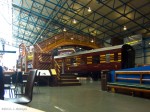
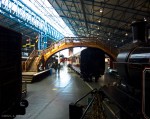
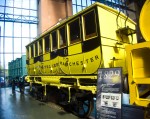
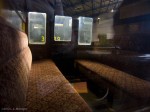
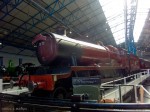
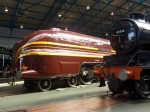
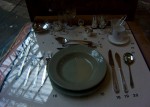
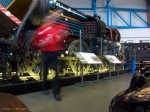
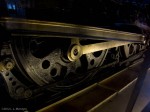
What a breathtaking murder story. This could make a good movie script, and with your accumulated blogging skills what better writer than you!
Really enjoyed this story and the pictures. When we are next in York, we surely will visit this site!!
I liked the picture of that delicious piece of victorian cake so much that my mouth began to water. I thought that the idea of trains imitating the stagecoach was a great one. Never heard it before. Thanks for sharing it.
Thanks for the comments, everybody! Glad you all enjoyed the story, etc!
@Will, thanks, this would this would make a good movie, wouldn’t it. Do you think a blog post is almost long for the script for a short subect? 😉
@Judie -thanks! I know you didn’t have time on your recent visit, so you’ll have to go back.
@Stan – thanks, that cake and tea was pretty tasty, particularly for a museum cafe. And it had that great view of that big room full of trains – fun!